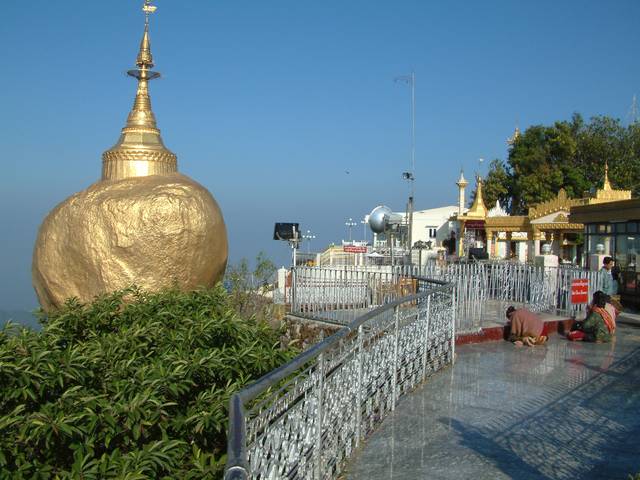Myanmar: Myanmar Geography Profile
2015/02/18

Myanmar consists mainly of a central lowland with mountains and plateaus. The lowland, which consists mainly of the Irrawaddy, Chindwin, and Sittang river valleys, extends some 700 miles (1,130 km) northward from the Irrawaddy delta. Concentrated here is most of the country's population. Enclosing the central lowland on the west and north are thickly forested mountains, which rise to more than 19,000 feet (5,800 m) in the far north. Rimming the eastern edge of the central lowland and occupying most of east-central Burma is the Shan Plateau, an undulating region that averages 3,000 feet (900 m) in elevation. Much of the plateau is drained by the Salween River, whose course is marked by numerous gorges and rapids.
Most of Myanmar lies within the tropics, and the low-lying areas have warm weather all year. In Mandalay, for example, average monthly temperatures vary from 68° to 89° F. (20° to 32° C.); in Rangoon, from 77° to 86° F. (25° to 30° C.). The highest temperatures occur in April, just before the summer monsoon rains begin. The rains continue through October, by which time most of the year's total rainfall has been received. Rainfall along most of the coast totals more than 200 inches (5,000 mm) a year, with amounts gradually decreasing toward the interior. In the central lowland around Mandalay and Myingyan is an area known as the Dry Belt, which receives less than 40 inches (1,000 mm) a year.
Burma is characterized by its central lowlands with the Sittaung Valley and Chindwin Valley and the small mountain ranges of Zeebyu Taungdan, Min-wun Taungdan, Hman-kin Taungdan and Gangaw Taungdan as well as the Bago Yoma.The Central Valley Region is ringed by steep, rugged highlands, with the country's highest point at the 5,881 m (19,295 ft) Hkakabo Razi located in the northern end of the country. This mountain is part of a series of parallel ranges that run from the foothills of the Himalaya through the border areas with Assam, Nagaland and Mizoram. The Arakan Mountains in the west run from Manipur into western Burma southwards through Rakhine State almost to Cape Negrais in the shores of the Bay of Bengal. The Arakan Range includes the Naga Hills, the Chin Hills, and the Patkai range which includes the Lushai Hills.Mountain ranges in the southern end of the Hengduan System form the border between Burma and China.
The Pegu Range is a relatively low mountain chain between the Irrawaddy and the Sittaung River in central Burma. In Eastern Burma the highest point of the Shan Hills is 2,563 m high Loi Pangnao, one of the ultra prominent peaks of Southeast Asia.[3] The Shan Hills form, together with the Karen Hills, Dawna Range and Tenasserim Hills, a natural border with Thailand as well as the Kayah-Karen/Tenasserim moist forests ecoregion[4] which is included in the Global 200 list of ecoregions identified by the World Wildlife Fund (WWF) as priorities for conservation.[5] Southern Burma consists largely of the western slopes of the Bilauktaung, the highest part of the Tenasserim Range, which extends southwards forming the central range of the Malay Peninsula.
Main peaks
Hkakabo Razi, 5,881 m
Gamlang Razi, 5,870 m
Saramati, 3,826 m
Bumhpa Bum, 3,411 m
Mol Len, 3,088 m
Nat Ma Taung (Mount Victoria), 3,053 m
Kennedy Peak (Burma), 2,703 m
Sangpang Bum, 2,692 m
Loi Leng, 2,673 m
Mong Ling Shan, 2,641 m
Nattaung, 2,623 m
Loi Pangnao, 2,563 m
Point 2519, 2,519
Loi Lan, 2,131 m
Mela Taung, 2,080 m
Myinmoletkat Taung 2,072 m
Mulayit Taung 2,005 m
Mawhpung Bum, 1,874 m
Mount Popa, 1,518 m
Mowdok Mual, 1,052 m
Rivers
The Irrawaddy, the main river of Burma, flows from north to south through the Central Burma Basin and ends in a wide delta. The Mekong runs from the Tibetan Plateau through China's Yunnan province entering Northeastern Burma into Laos.
In the east the Salween and the Sittaung River run along the western side of the Shan Hills and the northern end of the Dawna Range. In the narrow southeastern part of Burma, the Ye, Heinze, Dawei (Tavoy), Great Tenasserim (Tanintharyi) and the Lenya rivers are relatively short and flow into the Andaman Sea. Further south the Kraburi River forms the southern border between Thailand and Burma.
Maritime claims
contiguous zone: 24 nmi (27.6 mi; 44.4 km)
continental shelf: 200 nmi (230.2 mi; 370.4 km) or to the edge of the continental margin
exclusive economic zone: 200 nmi (230.2 mi; 370.4 km)
Islands
Apaw-ye Kyun
Calventuras Islands
Cheduba Island
Coco Islands
Kaingthaung Island
Kalegauk Island
Kokunye Kyun
Kyungyi Island
Moscos Islands
Myingun Island
Nantha Kyun
Preparis
Ramree Island
Unguan
Wa Kyun
Zalat Taung
Mergui Archipelago
Auriol Island
Bentinck Kyun
Christie Island, the southernmost island of the group
Kadan Kyun, the largest island of the archipelago
Lanbi Kyun
Letsok-aw Kyun
Mali Kyun, the northernmost island of the group
Saganthit Kyun
Than Kyun
Thayawthadangyi
Zadetkyi
Southeastern Asia, bordering the Andaman Sea and the Bay of Bengal, between Bangladesh and Thailand
22 00 N, 98 00 E
Southeast Asia
slightly smaller than Texas
5,876 km
tropical monsoon; cloudy, rainy, hot, humid summers (southwest monsoon, June to September); less cloudy, scant rainfall, mild temperatures, lower humidity during winter (northeast monsoon, December to April)
central lowlands ringed by steep, rugged highlands
petroleum, timber, tin, antimony, zinc, copper, tungsten, lead, coal, marble, limestone, precious stones, natural gas, hydropower
destructive earthquakes and cyclones; flooding and landslides common during rainy season (June to September); periodic droughts
deforestation; industrial pollution of air, soil, and water; inadequate sanitation and water treatment contribute to disease
strategic location near major Indian Ocean shipping lanes
- Myanmar News
-
- AFGHANISTAN: UNWTO: International tourism – strongest half-year results since 2010
- MYANMAR: Myanmar steps up reforms to entice investors
- MYANMAR: Myanmar expands electricity access through small grids
- CHINA: Myanmar President arrives in China for visit
- MYANMAR: Rakhine airport in Myanmar to be built by tender
- AFGHANISTAN: Higher earning Why a university degree is worth more in some countries than others
- Trending Articles
-
- BOTSWANA: Africa: U.S. State Department To Get Experienced Diplomat in Key Africa Post
- BURUNDI: Burundi: Govt Rejects UN Accusations of Crimes Against Humanity
- CHINA: China Invites 5 Countries As Guests For BRICS Summit
- IRAN: Saudi Arabia denies warming relations with Iran
- ISRAEL: Finance Ministry: Housing market slower in July
- QATAR: Blockaded Qatar's economy troubled, but coping











